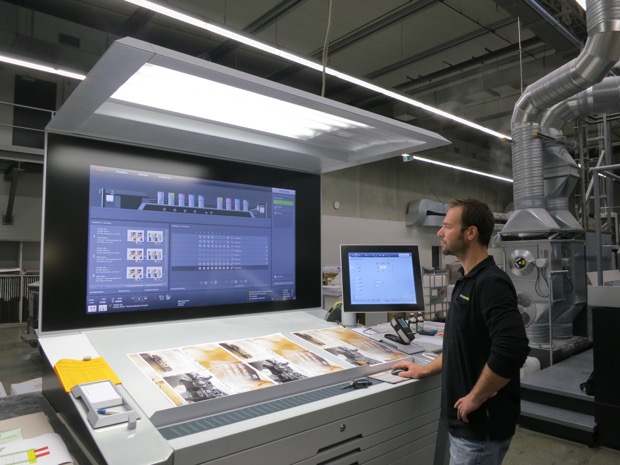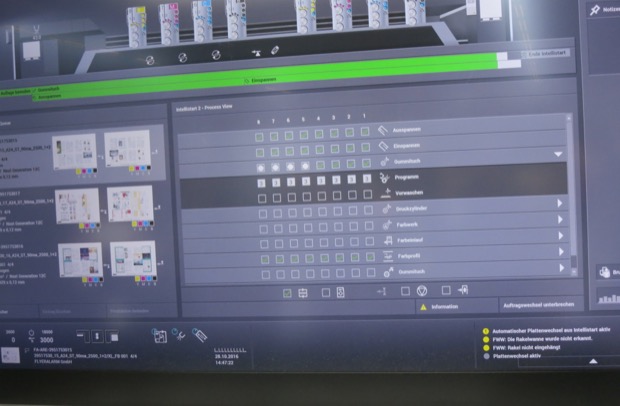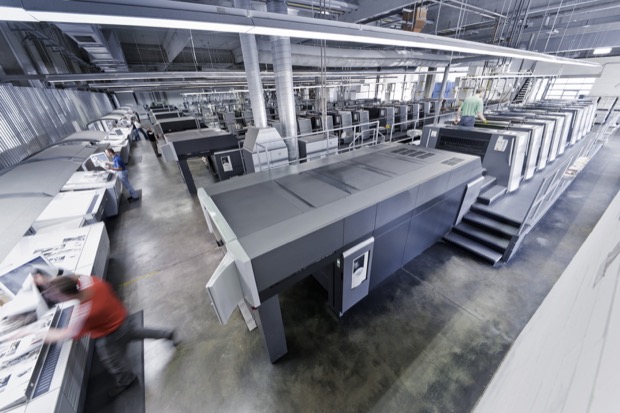“Push to Stop” the Presses: Heidelberg Demonstrates Concept of Autonomous, Navigated Printing
 http://www.ppc.ltd
http://www.ppc.ltd
Imagine a press so thoroughly automated that it almost seems to be a member of its own crew. This is what Heidelberg says it has made possible with the concept it calls “Push to Stop.”
By Patrick Henry
Published: November 8, 2016

During drupa 2016, Heidelberg Druckmaschinen AG put a good deal of effort into the debut of “Push to Stop,” a concept said to enable its Speedmaster sheetfed offset presses to run autonomously. Because drupa is a better venue for showing off production machinery than it is for sharing detailed explanations of technical advancements, the debut wasn’t all that Heidelberg found it needed to do to properly introduce “Push to Stop” to the offset world.
So, Heidelberg decided to have another try. It took place in the final week of October as a demonstration event for customers at the company’s main manufacturing center in Wiesloch, Germany, and as a trade press tour to three German printing companies now evaluating “Push to Stop” for themselves.
At the factory and at the print shops, “Push to Stop” appeared to be doing exactly what Heidelberg says it can do: automating presswork to a point where nearly the only task left for the operator to perform is to monitor the press as the machine completes jobs it sets up, commences running, and OKs for full production—acting almost entirely on its own self-generated instructions.
“Push to Stop” is not a product. It is a production capability arising from a collection of Heidelberg technologies that can be installed on certain Speedmaster presses to make them, in effect, the senior members of their own crews. Part of the capability is what Heidelberg calls “navigated” printing: the execution of a roadmapped sequence of events that the machine follows and displays in progress as if it were being guided by the pressroom equivalent of an automobile GPS.
Despite its unveiling at drupa, “Push to Stop” is not a launch in the usual sense. It consists of pre-existing solutions that Heidelberg, in an engineering Eureka moment, found a way to catalyze into something with a greater-than-the-sum-of-the-parts functionality for automated offset presswork.
By achieving this, says Heidelberg, “Push to Stop” brings conventional printing into the realm of “Industry 4.0”: the so-called fourth wave of manufacturing in which production systems run themselves and rely less on human oversight than on interactions with each other. More practically, Heidelberg sees “Push to Stop” as the key to increasing machine utilization beyond the relatively low levels that it says are the norm in most print shops.
Without “Push to Stop,” says Heidelberg, overall equipment effectiveness (OEE) at most plants is stuck between 20% and 25%: the presses produce less than a quarter of the sheets that they theoretically could print running at top speed, 24/7/365. Heidelberg claims that with “Push to Stop,” the OEE factor can as much as double—a surge with obvious implications for press-side logistics and other processes that let a print factory stay ahead of peak workloads.
The company also says that the seamless, robotic makereadies of “Push to Stop” can make offset much more competitive with digital in very short runs. One of the of the three German printers has made the point by running 200-sheet jobs on an eight-unit, 41” Speedmaster press at a unit cost he said digital could not beat.
According to Heidelberg, autonomous printing drives the entire operation to a new level of productivity by challenging press-supporting functions such as platemaking to keep up with the sharp increase in the number of jobs that a “Push to Stop” press can be expected to print per hour, shift, and year.
Boosting OEE and eliminating human touchpoints are crucial to profitability in an industry that is contracting, dealing with more numerous short runs, and trying to get by on prices that have not risen in the last several years, said Rainer Wolf, head of sheetfed product management for Heidelberg. Driving OEE means finding ways to “liberate” press crews from tasks that an autonomously operating press can carry out more precisely and much more rapidly—the objective of everything that “Push to Stop” does.
Wolf said that presses running in “Push to Stop” mode can proceed from job to job so independently that apart from making sure that plates and paper are ready to load, operators no longer have the kinds of hands-on printing responsibilities that non-autonomous production requires of them. Although “Push to Stop” processes can be overridden at any time, he said, crews will need to interrupt them only when there is a good reason—such as a customer’s request to pull and check a sheet—to deviate from the course that the press has set itself to follow.
That is the essence of “Push to Stop”: reconceiving presswork as a self-starting, self-controlling, self-sustaining process that needs little intervention as it moves forward. About 130 Heidelberg customers saw the concept in action at the factory in Wiesloch, where an eight-unit Speedmaster 106 perfector completed three jobs of 300 sheets each in just under eight minutes at 18,000 sheets per hour, including changeovers.

What autonomous printing looks like: on the left side of the Wallscreen XL press console, images of jobs queued for production; on the right, check boxes indicating status of makeready tasks; above, green bars showing progress toward makeready completion.
All makeready functions from ink settings to blanket washup took place without direction or assistance from the operators, whose main tasks were to deliver plates to the auto-feed units, watch job progress on the monitor, and insert good sheet count tabs into the delivery pile (a step carried out automatically by “Push to Stop” when the press is running in fully autonomous mode).
Heidelberg says that cost savings from this kind of autonomous production can be significant. For example, cutting two minutes of makeready from a press with a budgeted hourly rate of $300 recovers $10. Multiplying that by two makereadies per hour over two eight-hour shifts yields a savings of $320 per day. This enables a two-shift company operating on a five-day production schedule to save $1,600 per week and a total of $83,200 in a year.
Making autonomous operation possible is the latest version of Heidelberg’s Prinect workflow software driving the company’s most extensively automated sheetfed presses.
“Push to Stop” is a feature, at no extra charge, of Speedmaster XL 75, CX/SX 102, XL 106, and XL 145/162 press platforms equipped with the drupa 2016 generation Prinect Press Center XL 2 console; the Wallscreen XL console display; the AutoPlate Pro or AutoPlate XL 2 plate changing system; and Prinect Inpress Control 2, an inline color and registration inspection system. Eligible machines must be connected to Prinect 2017 with the Intellistart 2 job changeover controller for full “Push to Stop” functionality. (“Push to Stop” also is the operating system for Heidelberg’s Primefire 106 production inkjet press.)
The software and the press systems take cues from each other to create a seamless and continuous production sequence. The mastermind component is Intellistart 2, which plots the most efficient sequence based on the job parameters it gathers and stores. Intellistart 2 sets the chain of makeready events in motion and, when makeready is complete, starts the run.
Inpress Control captures running color data and sends it to a software module called Quality Assistant, which determines when target values are matching reference values. This activates the good sheet counter and causes a tab separating good sheets from waste sheets to be inserted into the pile. The press continues printing until the job is complete, at which point it stops so that Intellistart 2 can initiate the changeover to the next job.
Everything is depicted on the Wallscreen XL display, which can show the operator graphical overviews of up to 30 stored jobs. The display uses check boxes and other indicators to update the status of makeready steps as they occur. The visuals for navigated printing come from Intelliguide, a software feature that uses moving green bars to trace overall progress toward the start of the job.
Heidelberg’s slogan for autonomous printing is Simply SMART: Simplified Manufacturing Allowing Repeatable Tasks. Smart production is under way on a job-by-job basis at each of the three printing companies on the trade media tour, where Speedmaster presses and Prinect assets offered practical demonstrations of the “Push to Stop” concept premiered at drupa.

The pressroom at Aumüller Druck.
The first stop was at Druckerei Lokay e.K. (Reinheim), a commercial shop that has made major investments in environmentally friendly manufacturing (in 2007, it became the first printing plant in Germany to achieve climate-neutral operation). Here, a “Push to Stop” enabled Speedmaster CX 102 press ran four back-to-back jobs of 1,500 sheets each, with minimal intervention by its operators.
druck pruskil (Gaimersheim) is an all-Heidelberg shop that specializes in printing for automotive customers. Its “Push to Stop” platform is a newly installed, eight-color Speedmaster XL 106 perfector that it acquired in anticipation of an increase in short-run work. The shop has found—as Heidelberg says—that standardized jobs without complex color requirements are the best candidates for autonomous printing. In the hands of “Push to Stop,” these can be made ready in about two minutes and 100 sheets—a notable improvement over non-autonomous makereadies taking 20 to 40 minutes.
There is also plenty of this type of work to do at Aumüller Druck (Regensburg), an industrial printing plant where more than 80% of jobs produced go to press without proofs. The shop’s autonomously operating, eight-color Speedmaster XL 106 was said to be capable of producing up to 50 jobs per shift. The ceiling is keeping the press supplied with plates and paper at the same rate it uses them up.
“Push to Stop” is a concept still in development, and the base of Heidelberg equipment capable of autonomous, navigated printing is just starting to take root. Wolf said that there are four plants with “Push to Stop” Speedmasters in Germany and that an additional 10 qualified presses—including two more for Aumüller Druck—will be delivered soon. Installations also are planned at plants in the U.S.
